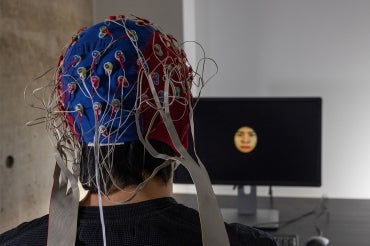2025-05-20 トロント大学(U of T)

Researchers at U of T Scarborough’s department of psychology are using electroencephalography (EEG) brain monitoring and AI to explore the so-called “other-race-effect” (photo by Don Campbell)
トロント大学スカボロー校の研究チームは、人工知能(AI)と脳波計測(EEG)を用いて、人が異人種の顔を認識しづらい「他人種効果(ORE)」の神経的仕組みを解明した。研究では、参加者が自人種と他人種の顔を見た際の脳活動を分析し、他人種の顔に対しては識別性が低く、曖昧かつ一般的な処理が行われていることが判明。さらにAIによる顔画像再構成では、他人種の顔を平均的で若く、表情豊かに記憶する傾向も確認された。これらの結果は、顔認識バイアスの根底に脳の情報処理の違いがあることを示し、顔認識技術や法的証言、精神疾患研究などへの応用が期待される。
<関連情報>
- https://www.utoronto.ca/news/brain-activity-ai-reveal-why-people-struggle-recognize-faces-other-racial-groups
- https://link.springer.com/article/10.3758/s13428-025-02636-z
- https://www.frontiersin.org/journals/human-neuroscience/articles/10.3389/fnhum.2025.1543840/full
GANを用いた画像再構成で他人種の顔知覚を解明する Unraveling other-race face perception with GAN-based image reconstruction
Moaz Shoura,Dirk B. Walther & Adrian Nestor
Behavior Research Methods Published:14 March 2025
DOI:https://doi.org/10.3758/s13428-025-02636-z
Abstract
The other-race effect (ORE) is the disadvantage of recognizing faces of another race than one’s own. While its prevalence is behaviorally well documented, the representational basis of ORE remains unclear. This study employs StyleGAN2, a deep learning technique for generating photorealistic images to uncover face representations and to investigate ORE’s representational basis. To this end, we collected pairwise visual similarity ratings with same- and other-race faces across East Asian and White participants exhibiting robust levels of ORE. Leveraging the significant overlap in representational similarity between the GAN’s latent space and perceptual representations in human participants, we designed an image reconstruction approach aiming to reveal internal face representations from behavioral similarity data. This methodology yielded hyper-realistic depictions of face percepts, with reconstruction accuracy well above chance, as well as an accuracy advantage for same-race over other-race reconstructions, which mirrored ORE in both populations. Further, a comparison of reconstructions across participant race revealed a novel age bias, with other-race face reconstructions appearing younger than their same-race counterpart. Thus, our work proposes a new approach to exploiting the utility of GANs in image reconstruction and provides new avenues in the study of ORE.
他人種顔認知の根底にある神経表象を明らかにする Revealing the neural representations underlying other-race face perception
Moaz Shoura,Yong Z. Liang,Marco A. Sama,Arijit De,Adrian Nestor
Frontiers in Human Neuroscience Published:05 March 2025
DOI:https://doi.org/10.3389/fnhum.2025.1543840
The other-race effect (ORE) refers to poorer recognition for faces of other races than one’s own. This study investigates the neural and representational basis of ORE in East Asian and White participants using behavioral measures, neural decoding, and image reconstruction based on electroencephalography (EEG) data. Our investigation identifies a reliable neural counterpart of ORE, with reduced decoding accuracy for other-race faces, and it relates this result to higher density of other-race face representations in face space. Then, we characterize the temporal dynamics and the prominence of ORE for individual variability at the neural level. Importantly, we use a data-driven image reconstruction approach to reveal visual biases underlying other-race face perception, including a tendency to perceive other-race faces as more typical, younger, and more expressive. These findings provide neural evidence for a classical account of ORE invoking face space compression for other-race faces. Further, they indicate that ORE involves not only reduced identity information but also broader, systematic distortions in visual representation with considerable cognitive and social implications.

